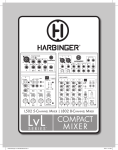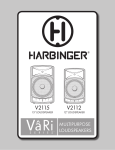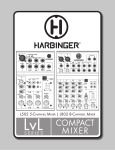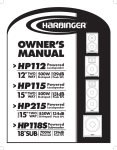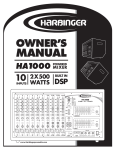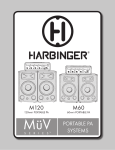Download View User`s Manual
Transcript
L2404FX-USB USB MIXER L2404-USB USB MIXER TABLE OF CONTENTS Welcome.......................................................................... 3 Main Features.................................................................. 3 Important Safety Instructions.......................................... 4 Front Panel Layout........................................................... 5 Front Panel Input Section................................................ 6 – 11 Control Section................................................................ 11 Effects Section.................................................................. 12 Monitoring and Level Control........................................ 12 – 15 Back Panel Layout........................................................... 16, 17 Recording and Playing Audio through USB.................. 18 Effects Preset Chart.......................................................... 18, 19 Troubleshooting............................................................... 19, 20 Glossary of Terms............................................................ 20, 21 Block Diagrams................................................................ 22 Mixer Specifications........................................................ 23 Warranty/FCC Statements............................................. 24 2 L2404FX-USB Owner's Manual L2404-USB USB MIXER WELCOME Congratulations on your recent purchase of a new Harbinger® LvL Series mixer. They are the perfect choice for bands, individual musicians and clubs who are looking for great-sounding mixes, live performance durability and the audio specifications that studio users demand. To get the most out of your new mixer, we suggest that you read through this entire manual at least once, then refer back to it as needed. MAIN FEATURES Mic Preamps The microphone preamplifiers for the L2404FX-USB were carefully developed to give you low noise, high gain microphone intelligibility. With the 50dB of gain and the professional quality 48V phantom power supply you can use studio quality condenser microphones with full assurance of getting the most headroom and clarity. Studio and Stage EQ Design Along with great microphone preamplifiers, the mixer also has a high quality, analog EQ section that was developed to offer a warm and full bodied sound for studio and stage recording environments. Effects Processor The internal Multi Core effects processors offers 24Bit/96k processing along with professional quality A/D and D/A convertors to give pristine audio conversion with high resolution effects. Built-in Compressors and Inserts One of the most important things needed for live and studio mixing are dynamic compressors. The L2404FX-USB has eight built-in compressors on the microphone inputs to help smooth out the typical issues with live recording. Along with this you can also use other studio outboard gear with the insert jacks on the mono microphone inputs. USB Audio Interface The L2404FX-USB mixer has a built-in, digital USB interface. This allows you to record and playback stereo audio to and from your computer. It offers true plug and play compatibility with the USB class compliant audio interface that is designed to work with most digital audio workstation software on your computer. www.HarbingerProAudio.com 3 L2404-USB USB MIXER IMPORTANT SAFETY INSTRUCTIONS DANGER Exposure to extremely high noise levels may cause permanent hearing loss. Individuals vary considerably to noiseinduced hearing loss but most will lose some hearing if exposed to intense noise for a sufficient period of time. Please use caution when using this device to avoid subjecting yourself or others to excessive sound pressure levels. THIS SYMBOL IS INTENDED TO ALERT THE USER TO THE PRESENCE OF NON-INSULATED “DANGEROUS VOLTAGE” WITHIN THE PRODUCT’S ENCLOSURE THAT MAY BE OF SUFFICIENT MAGNITUDE TO CONSTITUTE A RISK OF ELECTRIC SHOCK TO PERSONS THIS SYMBOL IS INTENDED TO ALERT THE USER TO THE PRESENCE OF IMPORTANT OPERATING AND MAINTENANCE (SERVICING) INSTRUCTIONS IN THE LITERATURE ACCOMPANYING THE UNIT. APPARATUS SHALL NOT BE EXPOSED TO DRIPPING OR SPLASHING AND THAT NO OBJECTS FILLED WITH LIQUIDS, SUCH AS VASES, SHALL BE PLACED ON THE APPARATUS. IMPORTANT SAFETY INSTRUCTIONS 1. 2. 3. 4. 5. 6. 7. Read all safety and operating instructions before using this product. All safety and operating instructions should be kept for future reference. Read and understand all warnings listed on the operating instructions. Follow all operating instructions to operate this product. This product should not be used near water, i.e. a bathtub, sink, swimming pool, wet basement, etc. Use only a dry cloth to clean this product. Do not block any ventilation openings. The product should not be placed flat against a wall or placed in a builtin enclosure that will impede the flow of cooling air. 8. Do not install this product near any heat sources, such as radiators, heat registers, stoves or any other apparatus (including heat–producing amplifiers) that produces heat. 9. Do not defeat the safety purpose of the polarized or grounding-type plug. A polarized plug has two blades with one wider than the other. A grounding-type plug has two blades and a third grounding prong. The wide blade or the third prong are provided for your safety. If the provided plug does not fit into your outlet, consult an electrician for replacement of the obsolete outlet. 10. Protect the power cord from being walked on or pinched, particularly at plugs, convenience receptacles and the point where they exit from the apparatus. Do not break the ground pin of the power supply cord. 11.When a cart is used, use caution when moving cart/apparatus combination to avoid injury from tip-over. 12.Unplug this apparatus during lightning storms or when unused for long periods of time. 13.Care should be taken so that objects do not fall and liquids are not spilled into the unit through the ventilation ports or any other openings. 14.Refer all servicing to a qualified service professional. Servicing is required when the apparatus does not operate normally or has been damaged in any way, including damage to the power cord or plug, damage due to liquids spilled or objects dropped inside the unit, dropping the unit, or anything else that interrupts normal use of the unit. 15.WARNING: To reduce the risk of fire or electric shock, do not expose this apparatus to rain or moisture. 16.Protective Ground Terminal. The apparatus shall be connected to an AC main socket with a protective earth ground connection. RISK OF RISQUE DE CHOC ELECTRIC SHOCK ELECTRIQUE NE DO NOT OPEN PAS OUVRIR CAUTION: To reduce the risk of electric shock, do not remove chassis. No user-serviceable parts inside. Refer servicing to qualified service personnel. AVERTISEEMENT: Pour réduire les risques d’incendie et d’électrocution, ne pas exposer ce matérial à la pluie ou à l’humidité. WARNING: To reduce the risk of fire or shock do not expose this equipment to rain or moisture. AVERTISEEMENT: Pour réduire les risques d’incendie et d’électrocution, ne pas exposer ce matérial à la pluie ou à l’humidité. RISK OF RISQUE DE CHOC ELECTRIC SHOCK ELECTRIQUE NE DO NOT OPEN PAS OUVRIR 4 L2404FX-USB Owner's Manual L2404-USB USB MIXER FRONT PANEL LAYOUT 18 24 25 27 28 26 19 31 32 30 29 33 34 36 35 23 22 21 17 20 1 16 15 10 2 3 4 www.HarbingerProAudio.com 5 6 7 8 9 13 11 12 14 5 L2404-USB USB MIXER FRONT PANEL INPUT SECTION 6 1 Mono Channels 1-8 These channels are designed for mono inputs, either microphone or line inputs. 2 Mic Input XLR connector for a microphone-level signal. This input will accept virtually any professional microphone. Some microphones, mostly condenser mics, need phantom power to operate. This input also sends +48V phantom power to a microphone when the Phantom Power is switched on. Switch on phantom power on the back panel of the mixer. If you're unsure if your mic needs phantom power, check the instructions or the manufacturer's website for information. Phantom power should not hurt most microphones, except for very old microphones or some ribbon microphones. If you have a device that plugs into the wall and has an XLR output (like a mic pre/channel strip, guitar multi-effects processor, computer interface), you should get an XLR-to-¼" TRS cable and plug it into the line input (below). 3 Line Input This is a ¼” input that accepts a line-level signal, such as those provided by most keyboards and other outboard gear. Either a balanced (TRS) or unbalanced (TS) cable can be plugged in here. High impedance devices, such as guitars, should be connected to a Direct Injection (DI) box prior to plugging into this input. The level of this input is also controlled by the gain control, explained below. Do not use both the microphone and line inputs on the same channel. The mixer will distort and the noise level will go up. L2404FX-USB Owner's Manual L2404-USB USB MIXER 4 5 Insert The insert jack is designed for inserting a dynamic processor or EQ into the signal path of the input. The jack is a TRS jack, which means that you need an insert cable, which is a Y cable with a stereo TRS plug on one end and two separate TS mono jacks at the other end. One of the mono plugs goes into the dynamics processor input and the other mono plug goes into output of the effects processor. This creates a loop of the output of the mic preamp from the mixer into the dynamics processor and then back into the mixer input (prefader). Gain Control Gain Control: Controls the input gain for the selected channel, from either the mic or line input. If the gain is set too low, the output signal will be noisy when you turn it up at the level control. If gain is set too high, it will distort. For best performance, set the gain while looking at the Level LED meters. Start with the Gain knob fully to the left. Press the Solo button next to the Channel Fader and press the PFL button under the Solo Mode Section beneath the LEDs on the right side of the mixer. You’ll see the level of the input shown as green, orange and red LEDs. Now slowly turn up the Gain knob. The signal should reach the orange LEDs during louder passages. If it reaches the red, the signal will be distorting so reduce the Gain a bit. Remember to keep some “headroom”, or additional space on the LEDs, to prevent the occasional very loud sound from distorting. Sidebar: "Why are there two volume controls?" The Gain and Level controls work together to get the best performance out of the mixer. A quiet signal may need more gain than a loud guitar amp going into a sensitive microphone. Set the gain so that the level on each channel is roughly the same, then use the Level controls to set the balance that you want in your mix. 6 Compressor A compressor is a dynamics processor that increases the perceived loudness of the signal by evening out the loud and quiet passages for a more consistent signal level. This knob controls the threshold of the Compressor. Turn the knob to the right to lower the threshold, which increases the perceived loudness. Turn the knob all the way to the left to raise the threshold. While the knob is in the "OFF" position, no practical signal will reach the High threshold. Therefore, the Compressor will be percieved as OFF. 7 HPF Switch This button turns on the High Pass Filter, which acts as a rumble filter to help decrease low frequency noise beneath 75Hz, such as 60Hz hum from AC power from connected or nearby electronics or appliances or noise from walking on the stage when a microphone is on. www.HarbingerProAudio.com 7 L2404-USB USB MIXER 8 9 8 EQ Section The Mono channels of the L2404FX-USB have a 3 band EQ with a sweepable mid frequency. The high and low equalizers are shelving filters that are plus or minus 15dB at their frequency bands. The high EQ boosts or cuts all frequencies above 12kHz. Turn it up to bring out the breath of a vocal or the high overtones of the cymbals. Turn it down to reduce finger squeaks on a guitar or bass. The low EQ boosts or cuts all frequencies below 80Hz. Turn it up or down to change the character of the kick drum, bass guitar or the lower octaves of a keyboard or piano. The mid EQ is a semi-parametric EQ that has an adjustable frequency between 100Hz and 8kHz. Use the Mid knob to set the amount of boost or cut and use the Freq knob to set the frequency. Aux Sends The Aux Send is a separate bus on the L2404FX-USB mixer. This means that you can have a different mix on the aux bus than you do on the main outputs. This comes in handy in a few scenarios: • Sending different amounts to the effects section, so that some instruments have more reverb than others • Setting up a headphone mix, so that a recording musician can hear exactly what they want while you listen to your own mix • Creating a monitor mix on stage, so that band members can hear what they need to perform while you mix for the rest of the audience 10 Pre/Post Fader Button This button switches the fader control from Pre or Post. For normal mixing operations, set the button to Post Fader. If using the Aux bus for monitoring set it to Prefader. 11 Pan The Pan control moves the signal between the left and right outputs. When turned fully to the left, that channel will only show up on the left main output. When turned to the center, it will be sent in equal volumes to the left and right outputs. Turned fully to the right, you will only hear it through the right output. L2404FX-USB Owner's Manual L2404-USB USB MIXER 12 Peak LED The Peak LED lights up when the level coming into that channel is too loud. If you see this light flash, turn that channel's Gain control down and the Level control up. 13 Mute LED and Button Press this button to mute the channel. If the LED is lighted this means that you have the button pressed and that the channel is muted and there will be no audio sent to the main mix and post-fader buses. Pre-fader aux sends are unaffected by the mute switch. 14 Fader This controls the volume level of the channel coming into the mixer. Once you have the gain level set to not distort the input you should use the fader to control the volume of the input channel. 15 16 Channel Assignment Buttons These buttons determine where the input channels are routed. Pressing the Sub 1-2 button will send the channel to Subgroup 1 and 2. Pressing the Sub 3-4 button will send the channel to Subgroup 3 and 4. Pressing the MAIN L-R will send the channel to the Main Mix. Solo This Solo button allows the user to route the channel signal to the solo bus. This allows you to listen to the selected channel's signal without affecting the main output signal. The signal is either routed pre-fader or post-fader, depending upon whether or not the Solo Mode button is pressed. You can read more about solo mode in section 32. www.HarbingerProAudio.com 9 L2404-USB USB MIXER 17 Stereo Channels 9-16 These channels are designed to be either stereo inputs or mono inputs depending on how the inputs are used. For example, if you plug in two ¼” cables into the left and right ¼” inputs the signals will be stereo. However if you plug in a single ¼” plug into the left ¼” input the channel will sum to mono. These inputs accept standard +4dBu or -10dBv line level signals. The channel will also operate in mono if you plug a microphone into the XLR jack. Unlike channels 1-8 there are no compressors or inserts on these channels. There is, however, a 75Hz High Pass Filter (HPF) for low frequency noise on channels 9 – 12 as on the mono channels. The Gain knobs for the stereo channels 9/10 and 11/12 only influence the MIC input. The Gain knobs for channels 13/14 and 15/16 only influence the LINE input. Channel 11/12 can be used as a specific source for the USB audio input. So if you have a computer that will play music into the mixer you can specifically use this input by pressing the Source switch. This is handy for intermission music or backing tracks. You can read more about using the USB connectivity of the L2404FX-USB in the section labeled Recording and Playing Audio through USB. Channels 13 – 16 also have an Aux input that can be used for connecting mobile devices and other stereo sources via a 3.5mm unbalanced stereo cable. To use the Aux input, press the button beneath the channel labeled Line / Aux. When the button is off the channel will default to routing the left and right ¼” inputs. 18 Stereo Channel EQ Section Because channels 9 -16 are stereo channels, each EQ knob on the selected channel controls two EQs. The high and low EQs operate the same as on Mono Channels 1 – 8. In order to match the performance of each side of each stereo channel, the Mid EQ has been replaced by a fixed high mid and a low mid EQ. These are peaking EQs set at 3kHz and 500Hz, respectively, with +/-15dB of gain. 19 Stereo Channel Aux Sends These aux sends operate like the aux sends on mono channels 1 – 8. 10 L2404FX-USB Owner's Manual L2404-USB USB MIXER 20 21 Balance (BAL) The Balance knob has a similar effect to the pan control explained in the previous section, but the balance control just turns down one input or the other. As you turn the Balance knob to the right, the signal coming into the Left/Mono input gets softer. This allows you to control the panning in your mix without collapsing the stereo width of the input. 2TK Input and Output These 2 Track unbalanced stereo RCA inputs can be used for connecting additional external stereo audio sources such as CD players, tape machines or mobile devices. This stereo input can be routed to the Control Room Outs, Phones or Main Outputs by pressing the appropriate switch in the control section. The 2 Track outputs mirror the Main Mix output and their level is controlled by the master fader. CONTROL SECTION This area of the mixer is used to route the signal paths that come from the input channels to the Main Outputs, Subgroups or Aux Send/Returns. It is also where the controls for the Multi Core effects processor are located. 22 Effects Footswitch Input This input is for an external footswitch controller that can be used to turn on and off the internal Multi Core Effects Processor. 23 Phones Output This is a stereo output for driving a pair of headphones. The output level is controlled by the Control Room/Phones knob. www.HarbingerProAudio.com 11 L2404-USB USB MIXER EFFECTS SECTION The L2404FX-USB mixer has a built-in Multi Core effects processor to make it easy to set up high quality effects for your mixes. Preset The L2404FX-USB mixer Multi Core effects processor has 25 presets. Each of these is a different effect type. The preset names will show on the LCD display. Please see the list of Effects on page 19. To select an effect type: 1. Turn the large encoder knob above the LCD to select the effect preset 2. Once you select the effect press the encoder button to confirm the change 3. Note: time-based effects such as Delay or Tremolo will show the acronym “BPM” for “Beats Per Minute” in the lower right hand portion of the LCD screen. To Change Parameters of an Effect You can change the character of the effect depending on the effect type. Each time-based effect, such as Delay or Tremolo has three editable parameters. Other effects will have two variations as well as two editable parameters. To change the parameters press the Parameter button to select between the first and second editable parameter. 1. Turn the encoder knob to change the value 2. Press the encoder button down to save the selected value 3. After a few seconds the display will return to the effect type name 4. If you want to change to the other parameter press the Parameter button again. The LED’s next to the button will indicate if you are on the first or second parameter 5. Turn the encoder knob to change the other value 6. Press the encoder button down to save the selected value 7. After a few seconds the display will return to the effect type name Tap Button On time-based effects presets, press this button at least twice at the desired tempo. This is useful for setting the delay time in tempo with the music. For example, if you want a quarter note delay, press the Tap button on two successive beats of the music and the delay time will jump to that tempo. The Tap button will blink according to the tempo you have selected. For non-time-based effects, the Tap button will allow the user to select between two different variations of the effect. Press the Tap button once to select the first variation. Press the Tap button again to select the second variation. MONITORING AND LEVEL CONTROL 24 12 Master, Subgroup and 2 Track Assignment to Phones and Control Room These buttons determine whether the Master, Subgroups and/or 2 Track inputs are routed to the control room/headphone outputs. L2404FX-USB Owner's Manual L2404-USB USB MIXER 25 Control Room and Phones Knobs These set the level of the outputs to the control room and headphones. 26 2 Track to Mix The 2TR to Mix button routes the 2 Track stereo RCA inputs to the main mix. The level of this input is controlled by the output level of the external audio device. 27 Power LED Indicates that the mixer is on. 28 48V Phantom Power LED Indicates that the main phantom power switch is turned on (switch on the back panel). Aux Send Knobs 1-4 These determine the master output level of all of the individual Aux Sends. There is a solo button to solo the specific Aux Send. 29 Aux Send Knob 4 FX This aux send can be routed to the Aux Send 4 Output, just as is done with Aux Send Knobs 1 – 3, however, it is also routed to the internal Multi Core effects module. The aux bus with effects applied is routed to the DSP Effects Output, which can in turn be routed with a cable to an external audio source. When a cable is inserted into the DSP Effects Output, the solo button will solo the Aux Send 4 post the internal Multi Core effect module. www.HarbingerProAudio.com 13 L2404-USB USB MIXER 30 Aux Return Knobs These knobs determine the level of the aux returns back to the mixer. Aux Return 3 can be routed to the main mix or control room. Aux Return 4 can be routed to the main mix and/or the subgroups by pressing the appropriate switches. Aux Return 4 is automatically routed to the internal effects processor as well. 31 Ext Aux Send These are for configuring the Aux Send 1 and 2 outputs with the internal Multi Core effects processor. The External Aux Send 1 Return button allows you to select routing between the analog Return A or the Direct FX Return to the Aux Send 1 and 2 Outputs, respectively. You can adjust the send level of the effects with the External Aux Send knobs. 32 Level Meter This 15 LED multi-segment display provides an accurate indication of the Master Out or selected Solo signal level. MAX MAX ON 33 Solo Mode Button (AFL and PFL) and LEDs This button allows you to switch the solo mode between After Fader Listen (AFL) and Pre Fader Listen (PFL) operations. When the button is pressed, the signal will be routed from the solo sources post-fader and the AFL LED will be lit. This means that the position of the channel fader(s) that is being soloed will determine the level heard when monitoring this channel in the Control Room and Headphones. When the Solo Mode button is not pressed, the solo will be in Pre Fader Listen (PFL) mode and the PFL LED will be lit. Use the solo function in PFL for setting the gain on inputs and use AFL for normal soloing operations, such as reviewing an individual or selected number of channel input signals to hear how they sound before they are routed to the main mix. Solo Mode LED and Button This solos the channel input to the mixer so you can only hear this channel coming into the mix. The LED is lighted only when this button is pressed. 14 L2404FX-USB Owner's Manual L2404-USB USB MIXER 34 Subgroup to Main Mix Routing Buttons This is where you can assign the input channels of a subgroup to the main mix. You can route a subgroup to another mixer or send them out of the subgroup outputs to a recording device. Subgroups can be useful for submixing several input channels into a mono or stereo mix to be controlled by the faders in the subgroup mixer in the control section, for example allowing the ability to control a multichannel drum mix via two subgroup faders (left and right), rather than say, eight separate individual faders. 35 Subgroup Faders These faders control the levels of the subgroups. 36 Master Fader This fader controls the volume of the master outputs. www.HarbingerProAudio.com 15 L2404-USB USB MIXER BACK PANEL LAYOUT 1 2 10 3 1 2 3 4 16 4 5 11 6 7 8 9 Power Switch This switch turns on the power for the L2404FX-USB mixer. Be sure to have the switch in the off position when plugging and unplugging the mixer from the AC power cable. Any amplifiers or powered speakers connected to the mixer should be turned on after the mixer is turned on and turned off before the mixer is turned off, to prevent damage to amplifiers and speakers. Phantom Power Switch This switch turns on the 48V power to the microphone inputs of the mixer. This only should be turned on when connecting condenser type microphones to the mixer. Turn down the Master Volume before turning Phantom Power on to avoid loading circuit noise. The Phantom Power LED on the front panel will light when this is turned on. USB Interface Jack This is a Class Compliant USB 1.1 interface that allows you to connect the mixer directly to and from a computer to play and record stereo audio. Main Outputs The L2404FX-USB has two pairs of stereo outputs. One pair has XLR jacks and the other are balanced TRS ¼” jacks. Both can be used simultaneously. L2404FX-USB Owner's Manual L2404-USB USB MIXER 5 Main Inserts These jacks allow you to insert an external effects processor before the output of the main outputs. 6 Control Room Out The Control Room outputs are designed to allow monitoring of the mix by a sound engineer, often via studio monitor speakers in a separate room of a recording studio, however they can be used for other purposes as well. The level of these outputs is controlled by the Control Room knob on the front panel. This output is at line level and requires a power amp with speakers or powered speakers. 7 DSP Effects Out This is an unbalanced, stereo ¼” output which sends the signal from the aux send 4 bus after it has been routed to the internal Multi Core effects processor. 8 Subgroup Out The subgroup outs are balanced ¼” TRS outputs, which can be assigned for use by the individual channel assignment buttons and the corresponding subgroup out faders on the front panel. 9 Aux Return Inputs The aux return inputs are dual balanced ¼” TRS inputs, designed primarily for returning stereo signals back into the mixer after they have been routed from the aux send outputs to external effects processors. If you are using a mono signal back to the mixer you should use the left jack which will sum the input to mono. You can also use the aux inputs as additional inputs. 10 Aux Send Outputs The aux send outputs are balanced ¼” TRS outputs which are fed by the top panel Aux Send knobs. The aux send outputs are at line level so if you are using these for monitoring these should be connected to a power amp before going to speakers or connected directly to powered speakers. You can also use the aux sends to route signals to external effects processor and the effected audio from the output back to the Aux Return jacks. 11 Direct Outs These outputs send the signal from the first 8 mono input channels directly out from the mixer (post fader, post EQ and post Mute). www.HarbingerProAudio.com 17 L2404-USB USB MIXER RECORDING AND PLAYING BACK AUDIO THROUGH USB To Playback Audio 1. Connect your computer to the mixer with a USB cable. Your computer should see the mixer as a device labeled “USB Audio Codec”. 2. Select the mixer to playback audio from your system control panel. 3. Playback audio from your application. 4. Channels 11/12 are the playback channels for USB audio. Press the USB source button on this channel so that audio will playback. When the button is off, this channel will take its input from the microphone preamp or left and right ¼” inputs 5. If you don’t hear any audio make sure the fader for the channel is up as well as the main fader. To Record Audio 1. Connect your computer to the mixer with a USB cable. Your computer should see the mixer as a device labeled “USB Audio Codec”. 2. Select the mixer to playback and record audio from your system control panel. 3. Setup your mixer to have audio coming in as you normally would. 4. Start up your DAW application on your computer 5. Make sure your DAW application is setup to receive audio from the USB Audio Codec (the mixer) 6. Create an audio track on your mixer and enable it to record. To avoid a feedback loop turn down the fader on channel 11/12 or switch the USB source button to off. 7. Perform your audio on the mixer and record the track on your DAW application. 8. After recording you can play back the track from your computer to the mixer to hear the playback. Be sure to enable the USB input on the mixer or bring up the fader if you pulled it down when recording. EFFECTS PRESET CHART Preset 18 Name Variable Parameter Tap Control Description 1 CHORUS Depth, Speed Wav Shape Tri/Sine Chorus ensemble effect with short delays 2 FLANGER Depth, Res Oscillation Speed Classic stereo flanger with a slow sweep 3 PHASER Depth, Res Oscillation Speed Modulated sweeping effect 4 TREMOLO Depth Oscillation Speed Rapid reiteration of a note producing prominent overtones 5 DELAY Feedback, Mod Delay Time Simple mono delay, great for vocals and guitars 6 ECHO Time, Damp Delay Time Classic echo effect. Reflection of sound 7 RV-ROOM 1 Time, Pre Delay Dampening Bright/Dark Emulates a small studio room, great for adding ambience to drums and instruments 8 RV-ROOM 2 Time, Pre Delay Dampening Bright/Dark Emulates a large studio room, great for adding ambience to drums and instruments 9 RV-CHAM Time, Pre Delay Dampening Bright/Dark Gives the sound of a classical chamber, ideal for string, and wind instruments 10 RV-THEAT Time, Pre Delay Dampening Bright/Dark Gives the sound of a large theatre, great for adding ambience to instruments and vocals 11 RV-HALL Time, Pre Delay Dampening Bright/Dark Gives the sound of a concert hall, ideal for keyboards, string, and wind instruments 12 RV-CHURCH Time, Pre Delay Dampening Bright/Dark Gives the sound of a Church, ideal for keyboards, string, and wind instruments L2404FX-USB Owner's Manual L2404-USB USB MIXER 13 RV-PLATE Time, Pre Delay Dampening Bright/Dark Emulation of a 70's plate reverb - a smooth decay for instruments 14 RV-SPRING Time, Threshold Dampening Bright/Dark The sound of a spring reverb, adds a funky vintage sound to guitars 15 RV-GATED Time, Pre Delay Dampening Bright/Dark Gated ambience. Applicable to vocals and instruments 16 DETUNE Detune, Pre Delay Dampening Bright/Dark Slow pitch modulation with saturation 17 PSHIFTX1 Pitch Shift, Pre Delay Detune On/Off Pitch modulation with pre delay 18 PSHIFTX2 Shift A, Shift B Spread Narrow/Wide Pitch Modulation variation 19 VOCDBLER Detune, Delay Spread Narrow/Wide Vocal doubler effect - a Pitch Shifter with a slight echo to fatten vocals or guitars 20 DEL-CHOR Bal, Depth Delay Time Mono Delay with Chorus effect 21 REV-MDEL Bal, Time Delay Time Mono Delay with Reverb 22 REV-PDEL Bal, Time Delay, Time Reverb with a short stereo ping-pong delay 23 REV-CHOR Bal, Time Oscillation Speed Reverb and Chorus multi-effect, nice on keyboards 24 REV-FLGR Bal, Time Oscillation Speed Reverb with flanger multi-effect, interesting with guitar 25 REV-VOCD Bal, Detune Dampening Bright/Dark Reverb with vocal doubler multi-effect, great for pop vocals TROUBLESHOOTING In this chapter, we'll discuss common problems and their solutions, as well as who to contact if things go wrong with your mixer. A microphone is plugged in, but you don't see any level on the main meters. • Are the Gain and Level knobs turned up? • Is the Main Mix fader turned up? • If the mic needs phantom power, is the Phantom Power turned on? (Try it if you aren't sure.) • Try a different microphone cable and/or microphone. • Check the power connections, your power strip, extension cords, etc. You can hear everything, but it's very noisy. • Are all of the level controls turned up very high? Try turning those down and the gain controls up. Set the mixer to unity gain (see glossary). • T urn down the FX return. If that was the problem, try sending more signal to the effects by turning all of the aux knobs up. • Try turning down channels one at a time. If there is one channel that is contributing most of the noise, try fixing that at the source. You can see level on the meters, but can't hear anything through the control room speakers. • If the 2 Track RCA inputs is the source, is the 2 Track to Control Room/Phones button on? • If a Subgroup is the source, is the necessary channel Subgroup assignment switch on and the corresponding Subgroup fader up? • If Aux Return 3 is the source, is the Control Room/Main Mix button on so that the signal is routed to the Control Room? • Are the monitors switched on? • If only one output is working, try switching the left and right outputs. If the same channel isn't working, the problem is with the speaker. www.HarbingerProAudio.com 19 L2404-USB USB MIXER You turned up the Aux Return 4 knob, but can't hear the effects. • Are you sending enough level to the master Aux Send 4 output? If not, then turn up the individual channel Aux 4 Send knobs and then the master Aux 4 Send Knob. • Is the Aux 4 Return being routed to the intended bus in order for you to hear it? • If you are trying to route the Aux 4 Return to the Subgroups, press the Main Mix/Subgroups button and the button for the Subgroups to which you want to route the Aux 4 Return. Make sure the associated Subgroup faders are up and the button for the desired Subgroups is pressed in the Control Room/Headphones assignment section and the knob for the Control Room or Headphones is turned up as well. • If you want to route the Aux 4 Return to the main mix, make sure the Main Mix/Subgroup button is off and the Main Mix button is pressed in the Control Room/Phones assignment section and the knob for the Control Room or Phones is turned up as well. You turned up the Aux Return 4 knob, but can't hear the effects. • Are you sending enough level to the master Aux Send 4 output? If not, then turn up the individual channel Aux 4 Send knobs and then the master Aux 4 Send Knob. • Is the Aux 4 Return being routed to the intended bus in order for you to hear it? • If you are trying to route the Aux 4 Return to the Subgroups, press the Main Mix/Subgroups button and the button for the Subgroups to which you want to route the Aux 4 Return. Make sure the associated Subgroup faders are up and the button for the desired Subgroups is pressed in the Control Room/Headphones assignment section and the knob for the Control Room or Headphones is turned up as well. • If you want to route the Aux 4 Return to the main mix, make sure the Main Mix/Subgroup button is off and the Main Mix button is pressed in the Control Room/Phones assignment section and the knob for the Control Room or Phones is turned up as well. GLOSSARY OF TERMS BALANCED A 3-conductor (including shield), low-impedance connection. Balanced cables are the preferred method for hum-free interconnection of a sound system for their noise-rejection characteristics. (Also see Unbalanced.) BUS An output destination in a mixer, that allows for the routing of individual input signals. For example, the left and right main outputs are each called buses, because you can send a channel to one or both of them by using the pan or balance knob on the individual input channel. CHANNEL One of any number of signal paths in an audio circuit, such as input channel, output channel, recording channel, left channel, right channel, etc. DECIBEL (DB) A term representing the ratio between different audio levels. It can either refer to the electrical signal running through a channel or the acoustic sound level coming from a sound source. DELAY Like an echo, this effect duplicates the original signal, then plays it back at a rate you control. The rate at which these repeats occur is the “delay time.” 20 L2404FX-USB Owner's Manual L2404-USB USB MIXER EQUALIZATION Electronic filters that adjust the level of certain frequencies. Used for tone enhancement or to reduce extraneous sounds. Two types of EQ shapes are peak and shelving, described below. IMPEDANCE Resistance in an electrical circuit measured in Ohms (Ω). Maintaining proper impedance is important to correctly manage signal level, frequency response, and in the case of amplifiers and speakers, power loading on the amplifier. The output of a guitar, for example, is high impedance and should be connected to a Direct Injection box or “DI” if you want to connect it directly to a low impedance input on a mixer PEAK EQUALIZER CONTROL Increase or decrease of a frequency range centered at a specific point, resulting in an EQ curve that looks like a hill (increase) or a valley (decrease). PHANTOM POWER A supply voltage that runs through a microphone cable to power condenser microphones. Harmless to microphones that don't need it, except for very old and/or damaged ribbon microphones. REVERB An audio effect that emulates the echo reflections and decay time of a large space. SHELVING EQUALIZER CONTROL Increase or decrease of all frequencies above or below a specific frequency. TRS Acronym for Tip-Ring-Sleeve — the three parts of a three-conductor (including shield) audio plug. TRS phone plugs are often used for “balanced” mono connections, or "unbalanced" stereo connections (e.g. headphones). TS Acronym for Tip-Sleeve, the two parts of an unbalanced, two-conductor (including shield) phone plug. TS connectors are sometimes called mono or unbalanced plugs or jacks. UNBALANCED A two-conductor (including shield), high-impedance connection. These are most commonly used for instrument connections and cable runs of less than 20 feet. RCA or “Phono” cables are unbalanced. UNITY GAIN This means that the inputs and outputs are set at the same level. To set the gain correctly, first set the fader to the unity marking on the fader channel (0). Then plug in the source to the input channel and adjust the Gain knob to the maximum you can before distorting the input. Usually you will see the Clip indicator LED flash, which means the gain input is too high. Adjust the knob so that the signal is below clipping. Once you have this balanced correctly you will have unity gain on the channel input. XLR The three-pin connector universally used for balanced audio connections. A balanced connection reduces outside noise and interference. (See Balanced above.) www.HarbingerProAudio.com 21 L2404-USB USB MIXER BLOCK DIAGRAM RTN-A/EFX TO AUX-1 RTN-B/EFX TO AUX-2 22 L2404FX-USB Owner's Manual L2404-USB USB MIXER MIXER SPECIFICATIONS L2404FX USB Specification and Technical Data Parameter Condition Value Frequency response (MIC IN @ -20 dB) Mic In to Main Out (Trim at 0 dB): 10Hz - 22kHz +0 -1dB THD(MIC IN @ -20 dB) Mic In to Main Out, 20Hz to 20kHz: (Trim at 0 dB, Main output at 0 dB) 0.007% Signal-To-Noise Ratio Mic In to Main Out (Trim at 0 dB): >85dB Preamp Noise (EIN) 20 Hz to 20 kHz, (150Ω source) –114 dB Residual Output Noise All level controls @ minimum >–88dB Common Mode Rejection Ratio (CMRR) Maximum Gain >50dB @ 1kHz Crosstalk Adjacent channels Same channel (stereo separation) –65dB –40dB MIC input Gain Control Range Channel 1 to 12 0 dB to +50 dB Phantom Power DC +48V Mono Input Gain Control Range Channel 1 to 8 +20 dB to –30 dB Stereo input Gain Control Range Channel 13/14, 15/16 –20 dB to +20 dB Equalization Mono Channel, High Mono Channel, Mid Mono Channel, Low Stereo Channel, High Stereo Channel, High-Mid Stereo Channel, Low-Mid Stereo Channel, Low ±15 dB @ 12 kHz ±15 dB @ Variable 100 Hz - 8 kHz ±15 dB @ 80 Hz ±15 dB @ 12 kHz ±15 dB @ 3 kHz ±15 dB @ 500 Hz ±15 dB @ 80 Hz Output Level Maximum +20 dBu Maximum Input Levels Mic Line Input Tape Input and Aux Return +12 dBu, Gain @ +10 dB +20 dBu, Gain @ 0 dB +20 dBu Input Impedance Mic Input Line Input Stereo Aux Returns CD/Tape In 2.6 kΩ, balanced 20 kΩ, balanced 20 kΩ, balanced 10 kΩ, unbalanced Output Impedance Main Ctrl Room, Aux Sends Tape Output Phones Output 240 Ω, balanced / 120 Ω, unbalanced 120 Ω 1 kΩ 25 Ω VU Meters(Input signal monitor) 15 Segments Red (+13 dB), First Amber(+10 dB), Least Amber(+4 dB), First Green(0 dB), Least Green(-35 dB) AC Power Requirements Standard IEC Receptacle 100V - 240V/AC 60Hz -50Hz Power Consumption 35W Fuse Rating Dimensions Weight (net) www.HarbingerProAudio.com T2.0AH 250V WxDxH 19.2" x 17.7 x 4.3 15.54 lbs. 23 L2404-USB USB MIXER WARRANTY Have a question about service, warranty or parts? Call 888-286-1809 (Toll Free) So we may serve you better, please register o n-line at www.HarbingerProAudio.com 2 YEAR HARBINGER LIMITED WARRANTY For warranty support, please visit our website at www.HarbingerProAudio.com, or contact our Support Team at 888-286-1809 for assistance. Harbinger will repair or replace the unit at Harbinger’s discretion. warranty and the implied warranties of merchantability and fitness for a particular purpose are limited to the two (2) year warranty period. Some states do not allow limitation on how long an implied warranty lasts, so the above limitation may not apply to you. There are no express warranties beyond those stated here. In the event that applicable law does not allow the limitation of the duration of the implied warranties to the warranty period, then the duration of the implied warranties shall be limited to as long as is provided by applicable law. No warranties apply after that period. This warranty does not cover service or parts to repair damage caused by neglect, abuse, normal wear and tear and cosmetic appearance to the cabinetry not directly attributed to defects in materials or workmanship. Also excluded from coverage are damages caused directly or indirectly due to any service, repair(s), or modifications of the cabinet, which has not been authorized or approved by Harbinger. This two (2) year warranty does not cover service or parts to repair damage caused by accident, disaster, misuse, abuse, burnt voice-coils, over-powering, negligence, inadequate packing or inadequate shipping procedures. Retailer and manufacturer shall not be liable for damages based upon inconvenience, loss of use of product, loss of time, interrupted operation or commercial loss or any other incidental or consequential damages including but not limited to lost profits, downtime, goodwill, damage to or replacement of equipment and property, and any costs of recovering, reprogramming, or reproducing any program or data stored in equipment that is used with Harbinger products. This guarantee gives you specific legal rights; you may have other legal rights, which vary from state to state. The sole and exclusive remedy of the foregoing limited warranty shall be limited to the repair or replacement of any defective or non-conforming component. All warranties including, but not limited to, the express Harbinger P.O. Box 5111, Thousand Oaks, CA 91359-5111 Harbinger provides, to the original purchaser, a two (2) year limited warranty on materials and workmanship on all Harbinger cabinets, loudspeaker and amplifier components from the date of purchase. All trademarks and registered trademarks mentioned herein are recognized as the property of their respective holders. FCC STATEMENTS 1. Caution: Changes or modifications to this unit not expressly approved by the party responsible for compliance could void the user’s authority to operate the equipment. 2. Note: This equipment has been tested and found to comply with the limits for a Class B digital device, pursuant to Part 15 of the FCC Rules. These limits are designed to provide reasonable protection against harmful interference in a residential installation. This equipment generate, uses, and can radiate radio frequency energy and , in not installed and used in accordance with the instructions, may cause harmful interference to radio communications. However, there is no guarantee that interference will not occur in a particular installation. If this equipment does cause harmful interference to radio or television reception, which can be determined by turning the equipment off and on, the user is encouraged to try to correct the interference by one or more of the following measures: • Reorient or relocate the receiving antenna • Increase the separation between the equipment and receiver • Connect the equipment into an outlet on a circuit different from that to which the receiver is connected • Consult the dealer or an experienced radio/TV technician for help 1507-1542345 www.HarbingerProAudio.com 24


























